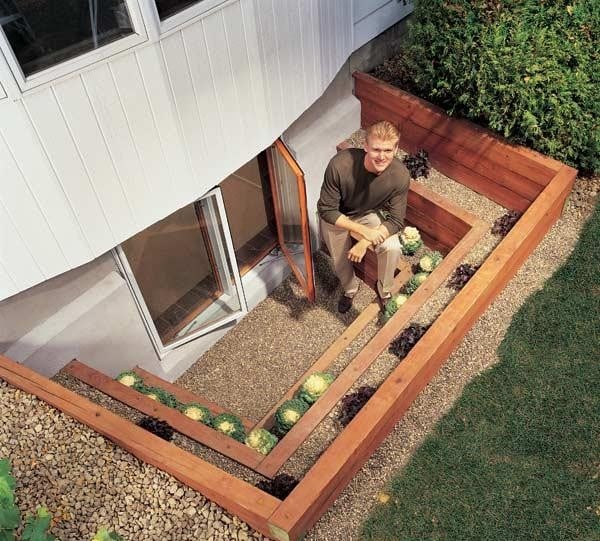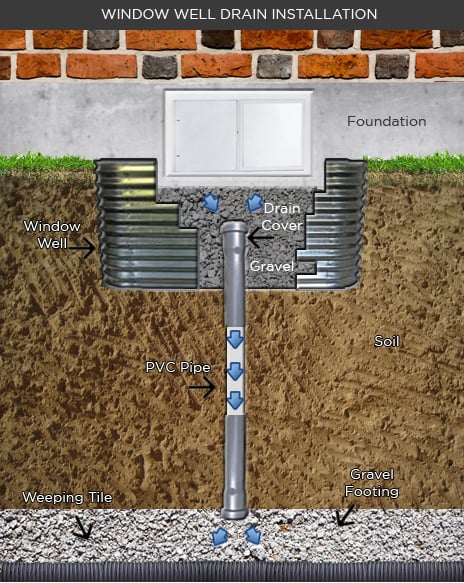Window wells and their impact on your home insurance
For a home with an underground basement, ground level windows can result in a living space that lacks natural light. That’s where window wells come in: these reinforced pockets of shovelled-out earth around basement windows allow more sunlight to peak in. And with the proper construction and drainage system in place, window wells can actually help drain excess rainwater and snowmelt away from a home’s foundation.
But like other structural aspects of a home, they need to be properly installed and maintained to avoid clogging, backup, flooding and subsequent water damage-related home insurance claims. Here’s what homeowners need to know about window well installation, materials, maintenance and common issues.
What is a window well, and why do homes have them?
Basements as living spaces is a fairly recent concept. Until the 1950s, many homes were built with unfinished basements that had low ceilings and were only used for things like cold storage, laundry, or to house the water heater and breaker panel. Today, basements are more likely to be useable living spaces for the family den, children’s playroom, guest bedroom, home office or a self-contained rental suite with its own entrance. By excavating the earth around ground-level windows to allow natural light to filter in, window wells can make a basement way more functional and livable.
Depending on local building code, particularly if the basement has a bedroom or is used as a rental unit, a window well may be required outside an egress window. An egress window is a window large enough to be used as an emergency alternate entrance/exit. Building code or not, If there’s no door in the basement that leads directly outside, you’re asking for trouble.
How to install window wells
To install a window well, dig a square or semi-circular area out of the earth around the basement window. The well should be about half a foot deeper than the bottom of the window to accommodate a gravel layer. The gravel layer connects to a drainage system. Using a cover or grate on top of your window well helps to keep out leaves, debris, water, snow, ice and animals.
The well itself is a solid barrier made of material such as galvanized steel, pressure treated wood, plastic or brick. Its size needs to fit the window dimensions and the depth of the hole. This part is really important—if the well doesn’t fit to the window, aligned with the foundation and securely fastened to the home, soil can sneak in from the sides. If it’s too short, soil can spill over from the top. When mixed together, water, soil, leaves and gravel are the perfect drain-clogging combination.
Before putting in a window well (or installing new windows), check your local building code. You want to understand the rules around egress windows, dimensions, clearance space and whether or not you need a building permit.
How a window well drainage system works
It seems counterintuitive: how does digging big wells around basement windows keep water out? But when installed properly, water should immediately drain through the gravel at the bottom. If it’s draining accordingly, water won’t accumulate or seep through the window. There are two drainage options for window wells:
- The well connects to an exterior perimeter drain (or weeping tile), an underground pipe that collects and redirects water away from the foundation.
- The well connects to an interior drain, which runs along the foundation of the house and collects and redirects water to a sump pit. When the pit reaches a certain level, the sump pump kicks in and pumps the water through a pipe that goes into the yard, or directly into the storm sewer system.
Are you looking for the best home insurance rate?
In less than 5 minutes, you can compare multiple home insurance quotes from Canada's top providers for free. Comparing rates online could save you hundreds of dollars.
Maintaining your window wells
Because of their ground level location, window wells can easily accumulate leaves, grass, sticks, twigs, litter or other debris. In fact, depending on the depth, they could even trap small animals. It’s a smart idea to give your window wells a good cleaning at least twice a year, in the spring and fall (just like rain gutters). This means clearing out any leaves and debris (watch out for spider webs), washing the window itself and checking the gravel to see if it’s still loose and draining water properly. In the winter, shovel out any snowfall from your window wells. You should also check to make sure ice buildup isn’t blocking the drainage system.
Like all aspects of your home, regular maintenance is important to uphold your home insurance or tenant insurance contract. If your insurance company finds the damage resulted from neglecting maintenance and repairs, your claim will likely be denied.
Drainage issues for window wells
While they’re great for natural light, the biggest issue that arises around window wells is drainage. Over time, wet leaves, dirt and other debris will clog up the gravel and cause water to pool. This is why cleaning and maintenance is important: a clogged window well can cause a few issues. First, water can leak through the window seal and pour into the basement. It can also seep into the basement walls, causing mould, or the home’s foundation, damaging and cracking it.
To test drainage quality, use a garden hose to spray some water into the window well. If it drains immediately, it’s in good shape. If water pools in the well, check the state of the state of the gravel. Gravel should be loose to drain effectively, but over time it will collect sand, soil and mud and will require cleaning or replacing so it continues to drain.
The bottom line
Whether you’re maintaining an existing window well or considering adding one to your home, it’s a feature that can provide valuable natural light and drainage properties. And, in a pinch, an emergency exit to a basement living space. But with water being the leading cause of damage behind home insurance claims, and with basements being particularly vulnerable to flooding, insurers will look at window wells and ask about previous water damage when assessing your home insurance quote. Keep your window wells clean and check them regularly, and the only thing streaming in will be sunlight.
ALSO READ

